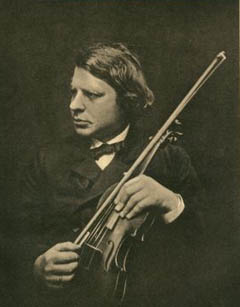by Diane Houser, violin/viola and private teacher
There are so many strings on the market and each type of string has its own characteristics, which can dramatically alter your instrument's responsiveness, volume, playability and overall tone quality. Since every instrument is unique and will respond differently to different strings, experimentation is key, but how do you choose? Where do you start?
Your playing style can make a difference, as strings that are suitable for a bluegrass fiddler may not be suitable for a classical violinist.
There is a lot of confusion about strings, since there are no universal gauge or tension standards for manufacturers to follow, so let's clear up some of the mystery and take the fear out of experimenting with strings by explaining some basic terms. Hopefully this will allow you to make confident and informed string choices which will improve the sound of your instrument.
GAUGE
Very simply, the gauge of a string is it's diameter, or thickness. This is referred to by many string manufacturers in terms like Heavy, Medium or Light.
Most players use medium gauge strings, as they offer a good balance between tone, volume and response. Keep in mind that one brand's Medium may be vastly different than another brand's.
Thicker strings will give you more volume, punch and power, but because the bow response is slower, they are more difficult to control especially in soft passages, which can narrow your dynamic range. If your instrument sounds shrill, thin or strident, then your strings may be too thin - try a thicker, heavier gauge string.
Thinner strings require a lot less energy to play and will give you a brighter sound, a wide dynamic palette, very fast bow response, but they will have less power and projection. If your instrument sounds choked, dull, fuzzy or unresponsive, your strings may be too thick and the tension too high - try a lighter, thinner gauge string.
TENSION
String tension is the downward force on the top of the instrument along the length of the string, or the horizontal stretching force in the string It is determined by the mass (weight) of the material wound on the string as well as the frequency of vibration and string length. A thicker gauge string has more tension because it has more mass.
Higher tension strings sound louder and fuller, and can be played more aggressively than lower tension strings, but because they have more mass, it takes more force to move them, so they are less responsive to bowing.
Heavier gauge and high tension usually go hand in hand, which generally means that thin or light gauge strings with less mass, will be lower tension.
For heavy tension, you'll see words like Heavy, Thick, Stark and Forte
For lower tension, you'll see words like Soft, Light, Dolce, Weich and Thin
When experimenting, I recommend that you start with the medium or Mittel tension & gauge first, but remember, these can be quite different from brand to brand, even if they are both called "medium." If you have an older vintage instrument, experiment with the lighter tension and gauge first.
CORE
The core of the string is what's on the inside, since most strings are wound with another material (see Winding).
Gut Core: These produce the darkest, richest tone and the most complex overtones. The response is slower than other string types which means they take a lot of energy to finesse, but they have a lower tension, so they feel good under the fingers. Gut is an organic, natural fiber, so it reacts drastically to changes in temperature and humidity. They take about a week of CONSTANT tuning to break them in, as they stretch a lot! They are also more expensive than most other strings. They don't last very long, so be prepared to change them monthly. I suggest you leave them for the musicians who perform early music on period instruments. DEFINITELY NOT FOR BEGINNERS!
Steel Core: These strings sound completely different from gut strings. They produce a pure, direct, bright and focused sound with less effort. They have a quick response, nearly instant break-in period, good pitch stability and a long life. They are a thinner gauge than other types, as steel is more dense and a thinner core is all that's needed to achieve the right mass. They are a good choice for any small sized, and any student-model instrument. Some instruments will sound tinny or excessively bright with steel strings, but they can give great clarity and power to an unfocused instrument. Excellent strings for jazz, country, bluegrass and rock musicians.
Synthetic Core: Made of nylon, or perlon, or composite fibers, these strings produce a richer, fuller, and warmer tone than steel core strings. Some have great range, producing a wide overtone spectrum, brilliant tone color and volume. They are designed to mimic the complexities of gut core strings without the problems. They are virtually unaffected by temperature and humidity changes, have a quick break-in period and good pitch stability. They last longer than gut, but not as long as steel core strings.
WINDING
Some common string winding materials include:
Titanium - lightweight and provides a warmer tone.
Carbon Steel - extremely durable and produces a very bright tone.
Chrome Steel - easy response and very durable, not quite as bright as Carbon Steel.
Tungsten - used to increase the volume output.
Gold-plating - used mainly on violin E strings to add sweetness to a bright tone.
Aluminum - warmer sounding and not as bright as carbon or chrome steel. Aluminum has the shortest lifespan, as it will gradually break down and dissolve from exposure to hand perspiration.
Daily cleaning of your strings will help to increase their life, but gradually strings lose brilliance, become less responsive and more difficult to play in tune. You'll want to change Synthetic Core strings at least every 4 - 6 months, though Steel Core strings may last up to 8 - 10 months.
Next time you're ready to change your strings, don't be afraid to experiment!
Fun fact: Gut strings are usually made from sheep gut, NOT from cats! The word catgut may have been an abbreviation of the word cattlegut, or it may have derived from kitgut - the word kit meaning fiddle.
There are so many strings on the market and each type of string has its own characteristics, which can dramatically alter your instrument's responsiveness, volume, playability and overall tone quality. Since every instrument is unique and will respond differently to different strings, experimentation is key, but how do you choose? Where do you start?
Your playing style can make a difference, as strings that are suitable for a bluegrass fiddler may not be suitable for a classical violinist.
There is a lot of confusion about strings, since there are no universal gauge or tension standards for manufacturers to follow, so let's clear up some of the mystery and take the fear out of experimenting with strings by explaining some basic terms. Hopefully this will allow you to make confident and informed string choices which will improve the sound of your instrument.
GAUGE
Very simply, the gauge of a string is it's diameter, or thickness. This is referred to by many string manufacturers in terms like Heavy, Medium or Light.
Most players use medium gauge strings, as they offer a good balance between tone, volume and response. Keep in mind that one brand's Medium may be vastly different than another brand's.
Thicker strings will give you more volume, punch and power, but because the bow response is slower, they are more difficult to control especially in soft passages, which can narrow your dynamic range. If your instrument sounds shrill, thin or strident, then your strings may be too thin - try a thicker, heavier gauge string.
Thinner strings require a lot less energy to play and will give you a brighter sound, a wide dynamic palette, very fast bow response, but they will have less power and projection. If your instrument sounds choked, dull, fuzzy or unresponsive, your strings may be too thick and the tension too high - try a lighter, thinner gauge string.
TENSION
String tension is the downward force on the top of the instrument along the length of the string, or the horizontal stretching force in the string It is determined by the mass (weight) of the material wound on the string as well as the frequency of vibration and string length. A thicker gauge string has more tension because it has more mass.
Higher tension strings sound louder and fuller, and can be played more aggressively than lower tension strings, but because they have more mass, it takes more force to move them, so they are less responsive to bowing.
Heavier gauge and high tension usually go hand in hand, which generally means that thin or light gauge strings with less mass, will be lower tension.
For heavy tension, you'll see words like Heavy, Thick, Stark and Forte
For lower tension, you'll see words like Soft, Light, Dolce, Weich and Thin
When experimenting, I recommend that you start with the medium or Mittel tension & gauge first, but remember, these can be quite different from brand to brand, even if they are both called "medium." If you have an older vintage instrument, experiment with the lighter tension and gauge first.
CORE
The core of the string is what's on the inside, since most strings are wound with another material (see Winding).
Gut Core: These produce the darkest, richest tone and the most complex overtones. The response is slower than other string types which means they take a lot of energy to finesse, but they have a lower tension, so they feel good under the fingers. Gut is an organic, natural fiber, so it reacts drastically to changes in temperature and humidity. They take about a week of CONSTANT tuning to break them in, as they stretch a lot! They are also more expensive than most other strings. They don't last very long, so be prepared to change them monthly. I suggest you leave them for the musicians who perform early music on period instruments. DEFINITELY NOT FOR BEGINNERS!
Steel Core: These strings sound completely different from gut strings. They produce a pure, direct, bright and focused sound with less effort. They have a quick response, nearly instant break-in period, good pitch stability and a long life. They are a thinner gauge than other types, as steel is more dense and a thinner core is all that's needed to achieve the right mass. They are a good choice for any small sized, and any student-model instrument. Some instruments will sound tinny or excessively bright with steel strings, but they can give great clarity and power to an unfocused instrument. Excellent strings for jazz, country, bluegrass and rock musicians.
Synthetic Core: Made of nylon, or perlon, or composite fibers, these strings produce a richer, fuller, and warmer tone than steel core strings. Some have great range, producing a wide overtone spectrum, brilliant tone color and volume. They are designed to mimic the complexities of gut core strings without the problems. They are virtually unaffected by temperature and humidity changes, have a quick break-in period and good pitch stability. They last longer than gut, but not as long as steel core strings.
WINDING
Some common string winding materials include:
Titanium - lightweight and provides a warmer tone.
Carbon Steel - extremely durable and produces a very bright tone.
Chrome Steel - easy response and very durable, not quite as bright as Carbon Steel.
Tungsten - used to increase the volume output.
Gold-plating - used mainly on violin E strings to add sweetness to a bright tone.
Aluminum - warmer sounding and not as bright as carbon or chrome steel. Aluminum has the shortest lifespan, as it will gradually break down and dissolve from exposure to hand perspiration.
Daily cleaning of your strings will help to increase their life, but gradually strings lose brilliance, become less responsive and more difficult to play in tune. You'll want to change Synthetic Core strings at least every 4 - 6 months, though Steel Core strings may last up to 8 - 10 months.
Next time you're ready to change your strings, don't be afraid to experiment!
Fun fact: Gut strings are usually made from sheep gut, NOT from cats! The word catgut may have been an abbreviation of the word cattlegut, or it may have derived from kitgut - the word kit meaning fiddle.





























